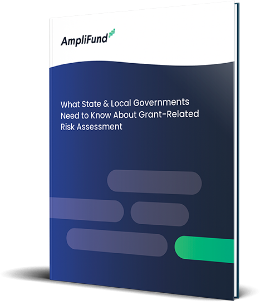Part 1: Common Challenges
State grant managers face enormous pressure as federal funding, provided through programs such as the American Rescue Plan Act (ARPA) and the Infrastructure Investment and Jobs Act (IIJA), has reached historic levels. Recent findings from The Pew Charitable Trusts show that states received 60.8% more federal grant funding in fiscal 2022 than just before the pandemic. With this influx of grant dollars comes expanded compliance requirements and performance standards. This adds even more challenges for state grant managers who already face mounting expectations, staff turnover, subrecipient management complexities, and resource limitations.
It may not surprise these grant managers that the five challenges that state grant offices commonly face, as identified several years back by the Government Accountability Office and Data Foundation, still persist. A path forward toward improved grant management to shore up compliance and optimize program impact is clearly needed.
In this first installment of our two-part State Grant Management: Challenges and Solutions series, we look into these common challenges in detail. In Part 2 , we share timely tips and solutions to help you improve your state’s processes and, in turn, increase your drawdown of grant dollars, amplify outcomes, and improve compliance.
Consider how these challenges impact your grant programs:
Challenge 1: Lack of internal controls
Your team manages dozens of grant programs, each with its own requirements and deadlines. Different departments handle processes, well…differently. Spreadsheets multiply. Email threads grow longer. Something as simple as tracking a grant modification becomes a time-consuming hunt through various systems and folders.
This challenge becomes even greater when managing multiple federal funding streams with varying requirements. And when subrecipients follow different processes for similar grants, monitoring performance effectively and maintaining compliance can feel nearly impossible. States that struggle to maintain consistent processes across departments or agencies amplify inefficiencies and compliance risks.
Without proper internal controls, grant programs are vulnerable to errors, delays, and audit findings.
Challenge 2: Lack of allocation of duties
Monday morning brings news of another federal grant opportunity. But who handles the application? Who reviews the budget? Who tracks performance metrics? Who monitors subrecipient reporting and performance? In many state offices, these questions trigger a round of meetings and emails as teams try to sort out responsibilities. Meanwhile, precious application time ticks away.
When roles aren’t clearly defined, important tasks either get duplicated or slip through the cracks.
Many state grant management offices face confusion over who handles specific grant management tasks, especially during key phases such as application, implementation, and reporting.
Challenge 3: Issues with non-compliance
It’s audit time, and your team is scrambling. That expense from six months ago? The documentation is somewhere in someone’s email. The performance report due date? It might have been last week. The modified budget approval? Check the shared drive…or was it the network folder? Did subrecipients submit proof that their expenditures aligned with award parameters?
Non-compliance can result in questioned costs, audit findings, or even the need to return funds.
New funding streams come with new compliance requirements that must be carefully tracked and met. Non-compliance often sneaks up through a series of minor oversights that compound over time.
Challenge 4: Improper monitoring of progress
The quarterly progress meeting is tomorrow, and everyone wants answers: How much have we spent? What outcomes have we achieved? Which programs are on track? Without proper monitoring systems, pulling together accurate progress reports becomes a stressful scramble through multiple data sources, often with conflicting information.
Monitoring is further complicated when aggregating performance data across numerous subrecipients, each potentially using different tracking methods and metrics. This challenge has grown more significant as federal agencies focus more on performance measurement and program impact.
Without adequate monitoring systems, states can struggle to track spending, performance, and outcomes across grant programs, which can result in wasted or lost funds, failure to reach goals, and eroding public trust.
See how the Nebraska Department of Economic Development significantly improved its reporting capabilities in our Client Spotlight.
Challenge 5: Lack of timeliness for grant closeout
The grant period is ending, and the closeout list seems to grow longer by the hour. The final financial reconciliation reveals unexpected discrepancies. Required documentation is scattered across various departments. Subrecipients must complete their own closeout process, creating a domino effect of dependencies and deadlines. Team members who started the grant have moved on to other organizations, taking institutional knowledge with them.
Late or incomplete closeouts can impact future funding opportunities and create audit issues.
Prioritizing activities to support closeout early in the award lifecycle often takes a backseat to urgent tasks and deadlines. As a result, steps that would ease closeout are delayed or never taken. Closeout becomes a very big lift when not addressed until the award comes to a close, and at that point, it becomes impossible to rectify issues since there was no opportunity to identify red flags earlier in the award.
Without a doubt, grant management at the state level is complex. However, once these common challenges are acknowledged, addressing them can create a powerful ripple effect where better internal controls lead to clarified role allocation that drives more effective monitoring, which improves compliance and results in a smoother closeout process.
Continue to Part 2 of our State Grant Management: Challenges and Solutions series, where we share best practices for addressing each challenge.
For more information about designing or redesigning your grants management processes for efficiency, download our State Government Guide to Managing Grants.





